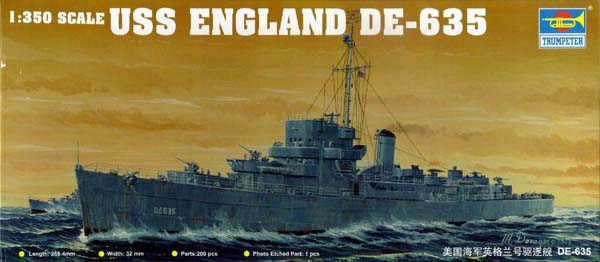05305 Trumpeter 1/350 USS ENGLAND DE-635
Couldn't load pickup availability
She arrived at Espiritu Santo 12 March 1944 from San Francisco, Pearl Harbor, Funafuti, and Guadalcanal. She took up escort duty between Espiritu Santo and Guadalcanal, occasionally sailing to Noumea, and once to the Marshalls. On 18 May 1944, with two other destroyers, England cleared Port Purvis on a hunt for Japanese submarines during a passage to Bougainville. During the next 8 days, she was to set an impressive record in antisubmarine warfare, never matched in World War II by any other American ship, as she hunted down and sank I-16 on 19 May, RO-106 on 22 May, RO-104 on 23 May, RO-116 on 24 May, and RO-108 on 26 May. In three of these cases, the other destroyers were in on the beginning of the actions, but the kill in every case was England's alone. Quickly replenishing depth charges at Manus, England was back in action on 31 May to join with four other ships in sinking RO-105. This superlative performance won for England a Presidential Unit Citation, and the assurance from the Chief of Naval Operations, Admiral E. J. King, "There'll always be an England in the United States Navy." His pledge was fulfilled 6 October 1960, when DLG-22 was assigned the name England. Through the summer of 1944, England sailed throughout the northern Solomons, providing the escort services necessary for the building up of bases, preparations for the renewed assaults on Japanese territories to the north, and provision of supplies to garrison forces on the islands of the southwest Pacific. In August, she underwent repairs at Manus, and between 24 September and 15 October voyaged from the Treasury Islands to Sydney, Australia. From the Treasuries, she sailed guarding a convoy to Hollandia, where she arrived 18 October, and on the 26th got underway on the first of two voyages to escort reinforcement convoys to newly invaded Leyte. She returned to Manus and local escort duty 2 December. From 2 January 1945, England escorted convoys between Manus and Ulithi, the major base for operations of the carrier task forces, and later to be the staging point for the assaults on Iwo Jima and Okinawa. The escort vessel sailed to Kossol Roads in February, bringing in a convoy later routed on to the Philippines, then resumed her duty on the Manus-Ulithi sealanes. She sailed from Ulithi 23 March for the preinvasion bombardment of Okinawa, returned to Ulithi to join the screen of two cruisers, guarding them back to Okinawa to join the 5th Fleet just after the initial assault on 1 April. Between 6 and 17 April, she voyaged to Saipan screening unladen transports, then took up a screening and patrol station north of the Kerama Retto. On 9 May 1945, while on station, England was attacked by three Japanese dive bombers. Her antiaircraft fire set the first of these flaming, but the plane crashed England on her starboard side, just below the bridge. The kamikaze pilot had remembered his instructions to knock out the ship's nerve center and kill as many as possible of her officers. With the bomb of the plane exploding just after the crash, England's men began a dangerous race against time, to quench the fires and save their ship, while combat air patrol shot down the two other attackers. She was able to make Kerama Retto under tow, with 37 of her men killed or missing and 25 wounded. England sailed on to Leyte, where she received temporary repairs to put her in shape for the long voyage home. On 16 July 1945, she arrived at Philadelphia for permanent repairs and conversion to a high-speed transport. The end of the war, however, halted this work, and she was decommissioned 15 October 1945 and sold 26 November 1946. In addition to the Presidential Unit Citation, England received 10 battle stars for World War II service quite a record for any Destroyer Escort.



